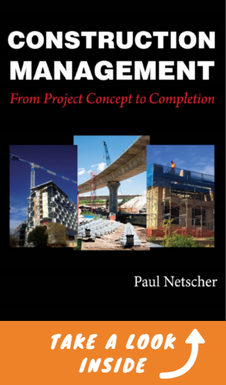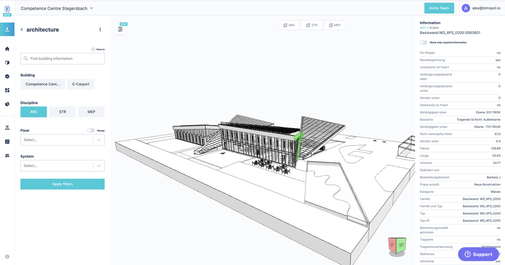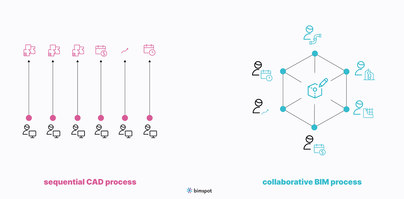|
Outside the construction industry, almost every business sector uses reliable data for decision making and has thus achieved higher quality and efficiency. Sure, the life cycle of a building, with all the people involved around it, is enormously complex. But we have finally arrived at the third decade of the 21st century and it's on us to move our industry towards digitalisation. To gain advantage from new technologies, we have to say goodbye to analogue processes and old-school tools. The good news is that the building industry has already taken the first steps towards this big revolution with Building Information Modelling (BIM). What is BIM all aboutIn the past few years, our software tools have evolved from 2D, the pencil on the screen, to a widely used 3D/BIM landscape. However, the most important thing when we talk about BIM, the process and cultural change, has been neglected for many years. But now, the misconception that BIM is the evolution of CAD has largely been dispelled, and the path of revolution in the construction industry towards collaboration and transparency is unstoppable. Companies across the industry are throwing old processes, business cases, contract models and silo mentality out the window to enter a new era of buildings, the era of BIM. BIM (Building Information Modelling) But what makes BIM so groundbreaking? Let me explain where we at bimspot see the enormous potential and how we understand BIM. In order to gain a broader perspective, let's first reduce Building Information Modelling to its three initial letters. The "I" of BIM The "I" for information is the core concept of BIM, but is also the biggest problem area of CAD. The concept itself is tremendously different and that's why we should not see BIM as an evolution of CAD. Rather, it is a 180° change in the way of thinking about buildings. During a building’s life cycle, a large amount of various kinds of information accumulates, which must be exchanged, evaluated and reused by a high number of stakeholders. All this information, its geometrical nature, physical data or movement data from an already operated building can only be evaluated and validated in the overall context. The usual CAD planning processes cannot provide this overall context, because they are based on separate local systems of all participants and are only exchanged and validated at certain intervals. BIM, on the other hand, takes a completely new approach: all the information is entered in 3-dimensional digital models and constantly shared with all participants via the cloud. This allows a direct insight into the current status of the project, and, in contrast to conventional planning, does not have to be interpreted first, which requires lots of technical knowledge and experience. To sum up, the "I" gives us the possibility to gain a deeper understanding of the current status of the project, to evaluate it in the overall context of the building and to use it directly in your particular use cases. The good news is that there is already a pretty good but also complex data schema, called IFC, out there. IFC enables a software independent exchange of our data. The "M" of BIM However, in order to understand BIM holistically, it is necessary to look at the "M" in two different interpretations. In the classic definition of BIM, the M stands for "modelling", i.e. the process of generating the 3D BIM models. This refers primarily to the planning phase, in which the majority of models are created by planners. If we interpret the "M" for management, a much broader field opens up and explains why BIM managers are indispensable for those projects to ensure a proper and successful venture. We have already defined that BIM is mainly about information that is created in a modelling process. However, in order to generate data in a targeted manner and based on the needs of the project and its participants, a sophisticated management is necessary to activate the well-known potential behind BIM. As part of the process, we can expect highly valid and conceptualised data. This, in turn, will give us the optimal basis for decision making at any given phase of the project, thereby increasing quality and helping us safely reach our goals. These changes in the planning, construction and operation of our buildings bring about a high degree of transparency and thus demand an enormous cultural shift; strictly separated partial services and contracts are to be replaced with joint, highly communicative ways of interdisciplinary cooperation. Each of us who takes part in these processes has dependencies on other involved stakeholders. This transparency and cooperation creates a win-win situation. The "B" of BIM Last but not least, we have to illuminate the "B" around the scope of this method. We are no longer talking about the keywords planning, construction and operation of a building or the medium "drawing" as in CAD. We are always talking about the entire building, regardless of project phases or the phase in the life cycle. Each operation in our buildings therefore refers to the one true data source, the BIM model, the living result of the process behind it. A holistic approach to BIM We must now give free rein to our creativity as to what applications we can use it for, whether it is precise prefabrication, predictive building maintenance, building evaluations or even just the coordination of building specifications in the planning stage. The holistic view on the digital twin gives us contextualised data with which we can make our decisions based on reliable data, decisions that will affect our buildings and thus all of us. What does BIM mean then? In summary, we can therefore conclude that BIM primarily means a process change triggered by the further development of our planning software. However, by changing the process over the entire life cycle of a building, which BIM requires, we can speak of a revolution. This is more powerful than the change to CAD and enables us to better understand the complex interdependencies in a building and thus increase our quality. Let us continue to develop the exciting field of BIM together and build a better and more sustainable environment. Author: Alexander Grass is a BIM Specialist and Senior Product Manager at bimspot, an open BIM project platform which combines all building information models into a single project environment focusing on the improvement, visualization and accessibility of building information. www.bimspot.io Do you want to learn how to manage construction projects successfully? Paul Netscher has written several easy to read books for owners, contractors, construction managers, construction supervisors and foremen. They cover all aspects of construction management and are filled with tips and insights. The books are available in paper and ebook from most online stores including Amazon. construction management construction project management
5 Comments
Knowledge is always power. It is the fuel for your creativity and other professional abilities. When you have adequate knowledge about the subject, you wiser you become at seeing the different angles of construction management and the situations that related to it. You can also immediately find the right solution to problems related to your field of work since you have studied and were trained for it. The pieces of training and seminars pertaining to the subject can help you widen your knowledge and learning by listening and taking notes of the substantial things taught by the speakers.
Reply
12/3/2021 06:48:17 pm
Stunning post! Thanks for the excellent presentation of your outline.
Reply
12/3/2021 06:56:00 pm
This is well worth a read. You presented great insight and information. Thanks.
Reply
18/3/2021 09:32:06 pm
Great argument for BIM, thank you. I would value your thoughts on the application of point cloud data to BIM, both during the construction phase and during the wider building lifecycle.
Reply
Leave a Reply. |
Archives
June 2024
Note: We welcome genuine comments, especially comments that add additional information to the subject matter in the article. We however reserve the right to remove inappropriate comments, which includes comments that have nothing to do with the subject, comments that include inappropriate language, and comments that are an advertisement for a product or company, or which include an advertising link. Comments must be in English. We will not enter into discussion on why a particular comment was removed.
CategoriesCopyright 2016 - The attached articles cannot be reproduced for commercial purposes without the consent of the author.
The opinions expressed in the attached articles are those of the writer. It should be noted that projects are varied and different laws and restrictions apply which depend on the location of the contractor and the project. It's important that the reader uses the supplied information taking cognisance of their particular circumstances. The writer assumes no responsibility or liability for any loss of any kind arising from the reader using the information or advice contained herein. "I have what I consider some of the best books on construction management."
Books are available from: Amazon.com Amazon.co.uk takealot.com kalahari.com Amazon.in Amazon.de Amazon.fr Amazon.it Amazon.com.au Powell's Fishpond uread bokus Amazon.ca Amazon.es Other retail stores Available in paperback or on Kindle "28 YEARS OF CONSTRUCTION PROJECT MANAGEMENT EXPERIENCE, DEVELOPING SUCCESSFUL CONSTRUCTION PROJECT MANAGERS AND BUILDING SUCCESSFUL CONSTRUCTION COMPANIES"
|





 RSS Feed
RSS Feed




